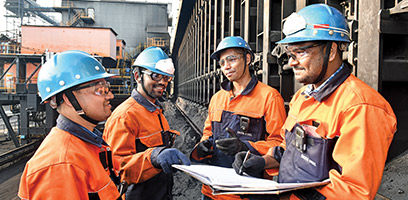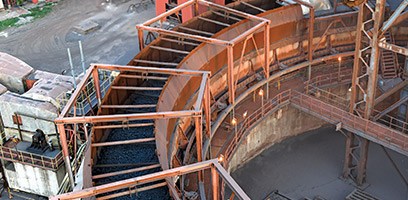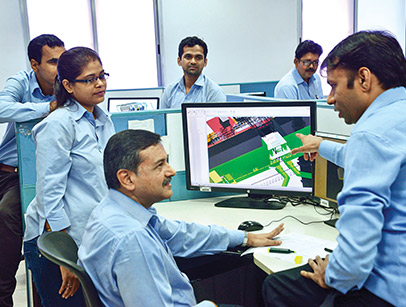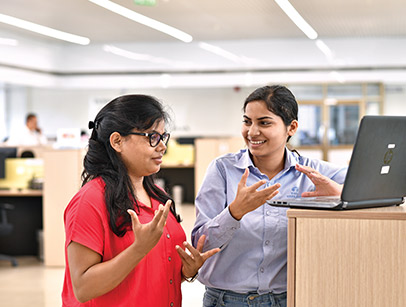At Tata Steel, we are in constant pursuit of minimising our environmental footprint and conserving the natural environment around us. Our philosophy of resource efficiency guides our investment decisions to monitor and mitigate the impact of our operations.

Tata Steel aims to achieve emission intensity <2 tCO2/tcs by 2025. We continue to implement Internal Carbon Pricing in our capital expenditure appraisal process with the shadow price of carbon at US$15/tCO2.
Highlights of our CO2 emission reduction projects:
Carbon Capture and Use (CCU) at TSJ and at the Ferro Chrome plant at Bamnipal, Odisha
Assessment of renewable energy potential across our locations in India
Maximisation of scrap utilisation in steelmaking

Upgradation of air pollution control equipment and better environment management in Jamshedpur, resulting in 25% reduction in dust emission since FY 2016-17
Pollution control system operations established at Kalinganagar resulting in 56% reduction in dust emissions from the first year of operations in FY 2016‑17
2.31 tCO2e/tcs
GHG emission intensity
0.38 kg/tcs
DUST EMISSION INTENSITY
TSJ is the Indian benchmark for CO2 emission intensity at 2.29 tCO2/tcs and energy intensity at 5.67 GCal/tcs for steel production through the Blast Furnace Basic Oxygen Furnace route.
Rated ‘B’ in Climate
Change and Water
related disclosures
in 2019
Tata Steel Bara Tertiary
Treatment Plant
won the ‘Industrial
Water Project of
the Year 2019’
Award presented
by the Global Water
Intelligence (GWI)

<2 tCO2/tcs GHG emission intensity

Specific consumption of freshwater at
Jamshedpur was at an all-time best at
2.8 m3/tcs, which is also an Indian steel
industry benchmark
Constructed 177 water harvesting
structures largely for agricultural use and partly for domestic use
3.11 m3/tcs
Specific water consumption
Rated ‘B’ in Climate
Change and Water
related disclosures
in 2019
Tata Steel Bara Tertiary
Treatment Plant
won the ‘Industrial
Water Project of
the Year 2019’
Award presented
by the Global Water
Intelligence (GWI)

<2 tCO2/tcs GHG emission intensity

Steel is 100% recyclable and we are setting the bar in the industry with our steel recycling business that will help meet the growing demand for steel in a sustainable manner. It will formalise the scrap market in India and help the country transition to a scrap-based steelmaking route for a more sustainable future.
Recovered metal from steel slag is utilised in the steelmaking process and this scrap is used in steel melting shops, along with clean scrap and pooled iron.
Tata Steel handles ~17 MnTPA of by-products, which is converted and sold across 20+ product categories every year.
A steel scrap processing unit is under
commissioning at Rohtak, Haryana with a
5,00,000 tonne per year capacity.
Tata Steel has formed a Carbon Impact
Centre to have a focused intervention to
drive low carbon transition and initiatives
and to achieve a goal of carbon
neutrality in the long-term.
0.73 m3/tcs
Effluent discharge intensity
100%
Total solid waste utilisation
Continue investing in technologies to achieve the highest environmental performance standards
Sustain LD slag utilisation at 100%
Ensure no net loss of biodiversity at our mining locations






While Tata Steel’s current operations in India are not located in any of the identified biodiversity hotspots or protected areas, our mining operations (being extractive in nature) impact the flora and fauna in the region.
Therefore, we voluntarily partnered with the International Union for Conservation of Nature (IUCN) at our raw material locations in Jharkhand and Odisha for the implementation of biodiversity management plans.
100%
Total raw material sites covered under biodiversity management plan
Continue investing in technologies to achieve the highest environmental performance standards
Sustain LD slag utilisation at 100%
Ensure no net loss of biodiversity at our mining locations





Our inclusive programmes give us the opportunity to work with and help communities flourish with us. We have partnered with various organisations and will continue to deepen our engagement with communities.

Response to the COVID-19 pandemic
Have been spearheading a deep‑dive
into both the urban and rural
communities in Jharkhand and Odisha
since late March 2020 under a ten-point
agenda, #CombatCovid-19
The agenda includes:
8,02,095
LIVES IMPACTED THROUGH OUR INITATIVES DURING THE PANDEMIC
Prioritising maternal and child health
FY 2019-20 outcomes
97,000
PEOPLE EDUCATED ON THE HEALTH AND SURVIVAL OF WOMEN AND CHILDREN BEFORE, DURING AND AFTER CHILDBIRTH
Focus on water consumption and effluent discharge
FY 2019-20 outcomes
ASPIRE TO ACHIEVE SPECIFIC WATER CONSUMPTION OF <3 M3 BY 2025

Thousand Schools Programme facilitates education for children, through better teaching and learning methods, while improving school governance through School Management Committees.
Learning Beyond School is a fully-community-managed education resource centre that enables children to learn beyond school hours and become familiar with digital technology.
FY 2019-20 outcomes
3,400 youth
REACHED THROUGH 32 COMMUNITY-RUN EDUCATION RESOURCE CENTRES IN ODISHA
Residential camp schools, known as Masti Ki Pathshala, cater to children who are either dropouts or from vulnerable backgrounds engaged in child labour.
Saving Lost Childhood programme aims to reduce child labour in Jamshedpur.
FY 2019-20 outcomes
189
CHILDREN MAINSTREAMED UNDER MASTI KI PATHSHALA

Improving >2 million lives

Technical education institutes improve employability of the youth in our community through professional skilling courses.
Ek Pahal is a skilling initiative to constructively engage prison inmates by imparting in-house training to enable them to secure gainful employment, both within and outside the jail.
Digital skills for rural children imparted through a classroom-on-wheels, Kaushalyan, using an air-conditioned bus with workstations, an LED TV display as well as a trained computer faculty.
Nursing programmes to help address the issues of poverty, unemployment and mass migration through nursing training.
Outcomes
5.504
YOUTH ENROLLED
2,733
YOUTH TRAINED
2,197
YOUTH PLACED/SELF-EMPLOYED
Women Self-help Groups (SHGs) created in our communities to help impart skills and empower them to run an enterprise.
Outcomes
14,822
WOMEN EMPOWERED THROUGH SHGs
Improve agricultural productivity by investing in enhanced irrigation facilities for the community, waste land development and other allied activities.
Outcomes
17,032
FARMERS BENEFITED THROUGH AGRICULTURE PRODUCTIVITY TECHNIQUES AND ALLIED ACTIVITIES

Empower youth by training stakeholders and providing them access to unparalleled sports facilities and nurturing sporting talent with career potential.
Outcomes
53,844
YOUTH ENGAGED THROUGH DIFFERENT SPORTS ACTIVITIES

Samvaad serves as an international platform for discussion among tribal communities.
Outcomes
7
regional editions of Samvaad held across India
2,115 tribals
FROM 150 TRIBES OF 13 COUNTRIES ATTENDED THE SAMVAAD 2019 EVENT
Preserve literary and cultural tribal heritage in partnership with 12 tribal organisations.
Outcomes
23,005 students
OF JHARKHAND AND ODISHA STUDIED FIVE TRIBAL LANGUAGES IN 464 LANGUAGE CENTRES
Establish district models in improving access to quality education and healthcare for infants, mothers and adolescents
Continue to engage with tribal communities and nurture leadership potential among tribal youth
Explore partnerships with governments, social sector organisations, academia, experts and other organisations in the national and international development space
Adopt innovative ways of enhancing household income, community nutrition, completion of basic education till matriculation by all; dealing with endemic water deficiency, supporting the differently abled and enabling better self-governance among citizens at the Panchayat level






Investing in people, striving to be the employer of choice, while creating a safe and healthy workplace constitute key priorities for Tata Steel. Industrial harmony of 90-plus years and a century-old trade union is a testament to our culture of ‘working together’.
on roll (india)
in the workforce

We have instituted policies that drive a culture of safety consciousness and prevention across our entire operations. Our commitment is reflected in the successful ramp-up of the Kalinganagar facility while maintaining the best practices in health and safety.
Leadership capability building at all levels to achieve zero harm and promote a safety-positive behaviour
Outcomes
~44%
reduction in high potential incidents
Elimination of safety incidents on road and rail to achieve safe, efficient and smart transport
Outcomes
Competency and capability building to mitigate hazards and manage risks
Outcomes
Contractor safety risk management to engage and empower the sizeable contract workforce
Outcomes
Process safety management to ensure effective control of risks at high-hazard operations
Outcomes
1.2%
improvement in health index


We have implemented the Employee Productivity Framework across our facilities and we continue to identify redundancies through programmes such as right skilling, Sunhere Bhavishya Ki Yojna and a job-for-job scheme. We are making significant progress in simplifying the organisation structure, systems and communications.
We also have a Workforce Capability and Capacity Framework to assess capability needs across the workforce for skill and competence building, customer focus, organisational performance, innovation, health and safety, and environment and business ethics.

803 tcs/employee/year
in the workforce
₹152.33 crore
invested in employee training and development

MOSAIC, our marquee initiative, covers four aspects: Gender, Person with Disabilities (PwDs), LGBTQ+, and other marginalised sections of the society. Through this initiative, we are inducting female engineers in manufacturing, sensitising employees about diversity and inclusion, retaining and developing diverse talent, creating infrastructure to simplify lives of working parents and members of the workforce with special needs.
With the objective of enabling greater flexibility and empowering our people, we provide paternity leave for blue-collared workers, offer project-based and full-time roles to women willing to return to work after a hiatus, facilitate satellite office operation for those with location constraints, provide menstrual leave without approval to those that require it, provide adoption leave to single male and transgender employees, and so on.
17.5%
employees from the affirmative action community

25% diversity in workforce
Improve employee productivity
Be one of the best places for people to work
Zero fatality
2% improvement in health index year on year
